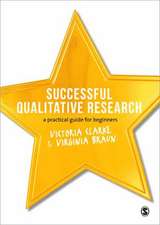How to Measure Attitudes: CSE Program Evaluation Kit, cartea 6
Autor Marlene E. Henerson, Lynn Lyons Morris, Carol T. Fitz-Gibbonen Limba Engleză Paperback – 18 feb 1988
Preț: 549.87 lei
Preț vechi: 646.92 lei
-15% Nou
Puncte Express: 825
Preț estimativ în valută:
105.23€ • 109.24$ • 87.74£
105.23€ • 109.24$ • 87.74£
Carte tipărită la comandă
Livrare economică 24 martie-07 aprilie
Preluare comenzi: 021 569.72.76
Specificații
ISBN-13: 9780803931312
ISBN-10: 080393131X
Pagini: 192
Dimensiuni: 140 x 216 x 11 mm
Greutate: 0.25 kg
Ediția:Revised
Editura: SAGE Publications
Colecția Sage Publications, Inc
Seria CSE Program Evaluation Kit
Locul publicării:Thousand Oaks, United States
ISBN-10: 080393131X
Pagini: 192
Dimensiuni: 140 x 216 x 11 mm
Greutate: 0.25 kg
Ediția:Revised
Editura: SAGE Publications
Colecția Sage Publications, Inc
Seria CSE Program Evaluation Kit
Locul publicării:Thousand Oaks, United States
Cuprins
An Introduction to the Measurement of Attitudes and Attitude Change
Essential Preliminary Questions
Selecting from Among Alternative Approaches to Collecting Attitude Information
Finding an Existing Measure
Developing Your Own Measures
Questionnaires
Developing Your Own Measures
Attitude Rating Scales
Developing Your Own Measures
Interviews
Developing Your Own Measures
Written Reports
Developing Your Own Measures
Observation Procedures
Developing Your Own Measures
Sociometric Instruments
Validity and Reliability of Attitude Instruments
Summarizing, Analyzing and Displaying the Data
Essential Preliminary Questions
Selecting from Among Alternative Approaches to Collecting Attitude Information
Finding an Existing Measure
Developing Your Own Measures
Questionnaires
Developing Your Own Measures
Attitude Rating Scales
Developing Your Own Measures
Interviews
Developing Your Own Measures
Written Reports
Developing Your Own Measures
Observation Procedures
Developing Your Own Measures
Sociometric Instruments
Validity and Reliability of Attitude Instruments
Summarizing, Analyzing and Displaying the Data
Descriere
This edition of How to Measure Attitudes draws on examples from a broader range of disciplines and professions than the first edition. It helps novice evaluators with the difficult task of assessing whether the affective and attitude objectives of a program have been met. The most commonly used attitude measures are described and sources of existing measurement instruments are listed. If no existing instrument is appropriate, step-by-step instructions are given enabling readers to construct their own. Methods for analyzing and reporting attitude data are also included.
















